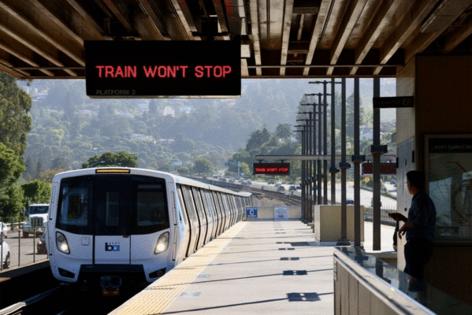BART restores service after computer glitch shuts down entire train system, stranding thousands
Published in News & Features
Commuters found themselves stranded at train stations across the Bay Area during the peak hours of Friday’s morning commute after a computer issue knocked out service to the region’s train system for more than four hours.
The Bay Area Rapid Transit (BART) was completely out of service from its opening at 5 a.m. Friday until just after 9 a.m., when train officials said they had restored service to its entire system. But officials said major delays remained likely “due to an earlier train control problem,” according to updates from BART.
Initially, officials said the train system was shuttered “due to a computer networking problem” BART officials shared in an early morning alert. “Seek alternate means of transportation.”
BART spokesperson Alicia Trost told KTVU-TV that stations in the East Bay would be coming back into service — from lines originating in Richmond, Antioch and Dublin/Pleasanton — for commuters to get to Oakland. From there, Trost said, commuters will be able to take buses or the ferry from Oakland to San Francisco.
The systemwide BART meltdown caused chaos in commutes across the San Francisco Bay Area. The heavy rail line, which connects five of the region’s most populous counties and ties together San Francisco with Oakland, is used by more than 150,000 commuters most weekday mornings, according to transit data.
Commuters were stunned to arrive at BART stations in the predawn hours Friday morning to find the gates to their stations shuttered, some with yellow caution tape wrapped around the fare gates. Many scrambled to make alternate arrangements, while traffic surged heavy across the Bay Bridge and rideshare services like Uber reported having higher fares due to increased demand.
BART officials encouraged riders to find transportation alternatives on its site, which appeared to recommend alternative bus lines.
A host of the region’s transit agencies tried to come to the aid of commuters. The San Francisco Bay Ferry system put its largest ferries into service and urged people needing transport from Oakland, Alameda, Richmond and Vallejo to take them. AC Transit, the bus system for the East Bay, were transporting buses filled with passengers over the Bay Bridge into the Salesforce Transit Center.
Friday’s major shutdown was the latest challenge for BART, which, like all the Bay Area transit systems, has struggled to regain ridership as fewer people have returned to the office after the COVID-19 pandemic.
The system has also struggled to combat perceptions of a lack of safety on the system and concerns about cleanliness, and is facing funding shortfalls as federal and state emergency funding is about to expire. To combat those challenges, BART has started to install more robust fare gates that are far more difficult for fare evaders to hop over. They’ve also started to operate shorter trains, as officials conceded that “there is safety in numbers” and allow for easier patrols.
BART raised fares by 5.5% in January to keep pace with inflation, with the average fare rising from $4.47 to $4.72. Riders have also reported enjoying the new BART cars that have replaced decades-old versions that sometimes lacked working air conditioning.
©2025 Los Angeles Times. Visit at latimes.com. Distributed by Tribune Content Agency, LLC.







Comments